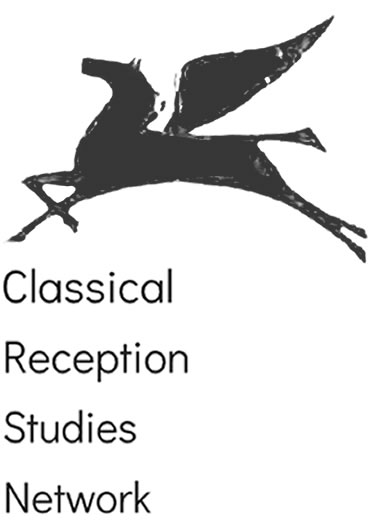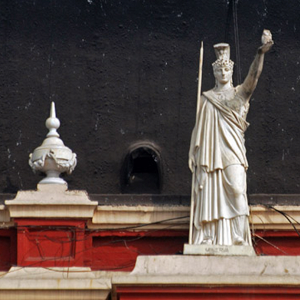This post is written by Shuvatri Dasgupta, a doctoral candidate at the University of Cambridge and a visiting researcher at the School of History, University of St Andrews.


Indians in the nineteenth century were accustomed to seeing classical female statues everywhere. They appeared in gardens and drawing rooms of elite landowning households (figure 1). A statue of Minerva adorned Writers’ Building, administrative headquarters of the British Government of Bengal, in Calcutta (figure 2). Historians of colonial India have charted the reception of Graeco-Roman antiquity in Indian political thought, literature, theatre, art, and architecture (Riddiford 2013; Vasunia 2013; Banerjee 2018; Banerjee 2018a; Majumdar 2023; Chakravarti and Prayer, 2023). However, scholars have not yet examined the impact of ancient Greece and Rome on modern Indian discourses about gender and sexuality. To address this research gap, this essay asks: how did invocations of classical antiquity shape models of womanhood in mid-late nineteenth century India?

Let me begin with the Bengali intellectual Pearychand Mitra, alias Tekchand Thackoor (1814-1883). In his book Ramaranjika (Treatise for the Entertainment of Women), published in 1860, Mitra invoked the story of Hercules at the crossroads between virtue and vice. The narrator, a sort of Hercules in a Bengali guise, dreamt that he stood at the intersection of two paths. Here, two women welcomed him and declared that this land was a microcosm of the world (samsara) itself. One path led to good conduct or virtue (dharma), and the other to misconduct or vice (adharma).
In Indian tradition, samsara denotes the world of transmigration, in which the soul passes from one life to the next (Monier-Williams 1899, 1119). Dharma embodies the ethical-moral principles which lead to good birth (Monier-Williams 1899, 510-12), and adharma to its opposite (Monier-Williams 1899, 20). Some scholars have argued that this ethicalized model of transmigration is Indo-European in origin (Watkins 1995, 283-4); others have specifically compared the ancient Greek and Indian traditions (Seaford 2020). In any case, the parallels between the two models enabled Mitra to transplant the tale of Hercules within an Indian ontology of virtue/vice-dictated transmigration. By placing this narrative in a book intended for a female readership, Mitra offered a compelling use of Greek tradition to shape modern Indian womanhood (Mitra 1860, 74-6).
We see a similar case in an anonymous Bengali translation (with commentary) of Semonides 7 (Types of Women), published in 1871 in Bamabodhini Patrika, a celebrated women’s periodical. Following Semonides, the piece classified women into ten categories, tracing their ancestry back to animals, insects, and other nonhuman beings. Almost all types of women were ridiculed for their immoral behaviour. Women descended from bees, however, were celebrated for their great virtue and household management skills. Written in 7th century BCE, Semonides’ patriarchal arguments relied on a fundamentally multispecies ontology, where humans could acknowledge nonhuman beings as their ancestors. The Bengali translator failed to comprehend this ontology. The translator-commentator claimed that since animals were inferior to humans, they could not be ancestors of human women. The Bengali translation of Semonides thus added a new modernist anthropocentrism/speciesism to the much older patriarchal discourse (Anonymous 1871, 45-8).
Bengali discourses on women were not simply expressions of misogyny. They were also intended to regulate women’s labour within the patriarchal household. Classical antiquity again came in handy here. In Ramaranjika, the treatise we discussed above, Mitra invoked Plutarch’s Parallel Lives to inform the Bengali reader about the wife of Phocion, an Athenian statesman and general. By then, Plutarch had been in wide circulation in Bengal for several decades. James Long referred to the Bengali text Satya Itihas (True History), modelled on Plutarch’s Lives, published in 1830 (Long 1855, 26). From the 1840s, students of Haileybury College, training to be administrators in British India, were translating Plutarch into Persian and other Indian languages (Clark 1843, xxi). A Bengali translation of Plutarch’s Life of Publicola was also a part of the school curriculum in some parts of Bengal (Government of Bengal 1865, 118). The gendered invocation of Plutarch thus fell on fertile soil. Plutarch had described Phocion’s wife as an ideal spouse who excelled in domestic labour. Based on that, Mitra underlined that Phocion’s wife, in spite of her elite status, did not rely on servants for cooking, fetching water, and cleaning the house. She performed all essential labour within the household (Mitra 1860, 12). Hence, Mitra hailed her as a venerable model for Indian women, thereby reinforcing gender-segregated labour practices in India.
Other Bengali authors, however, invoked ancient Greece and Rome to construct more politically active models of womanhood. An anonymous piece in Bamabodhini Patrika published in 1869 thus cited the case of Amazonian women warriors to inspire Indian women to be valiant political actors (Anonymous 1869, 45). The same volume contained another anonymous piece, ‘How Women Saved Rome’. The article commended the intervention of Sabine women in Roman politics. According to tradition, in 753 BCE, under Romulus’ leadership, men in Rome had abducted and forcibly married Sabine women. When the Sabine army retaliated by invading Rome, the Sabine women, who were by now wives of Roman men, acted as peacemakers to protect Rome. Led by Hersilia, the Sabine wife of Romulus, they argued that even though the marriages may have occurred by abduction, they were still legitimate. The author concluded that the women had saved Rome through their political acumen, implicitly suggesting that Indian women too could and should combine wifely devotion with political agency in liberating their country (Anonymous 1869a, 62-4).
The women of republican Rome were widely cited in this capacity in colonial Bengal. Both Mitra (1860) and the anonymous writers in Bamabodhini Patrika (1869) celebrated Cornelia, mother of the Gracchi brothers (Anonymous 1869, 45). Mitra underlined how Cornelia had shaped the political careers of her sons by instilling in them a paramount sense of loyalty to Rome. When they became martyrs (killed by the conservative faction in Rome), she glorified them for their patriotism. Mitra suggested that Indian mothers too should transform their sons into selfless patriots (Mitra 1860, 25).
Bengali/Indian invocations of ancient Greece and Rome, while discussing gender and sexuality, were unabashedly heteronormative. Naturally, this sat ill at ease with the plethora of non-heteronormative relationships depicted in the Greek epics. The Bengali women’s magazine Bharati thus published a series of essays in 1878, condemning the Iliad (Anonymous 1878). Homer was critiqued for not focusing adequately on heterosexual couples like Hector and Andromache. The essayist also criticized Helen’s ‘promiscuity’, and claimed that, due to her chastity, Sita, heroine of the ancient Indian epic Ramayana, was a much better character (Anonymous 1878, 48). A Bengali adaptation of the Iliad titled Helena Kavya (The Poem of Helen), written by Anandachandra Mitra in 1876, tried to address this gap by centring Helen, but was still vigorously criticized (Anonymous 1878a, 431). Bengali intellectuals seemed unable to accept an epic where homoerotic friendship and heterosexual promiscuity, rather than heterosexual monogamy, formed the heart of the narrative. Was heteronormativity then the reason behind the relatively limited popularity of the Iliad in colonial Bengal, and more widely in colonial India, as opposed to the ever-growing popularity of the Ramayana? Further research is needed to explore this hypothesis.
References:
- Anonymous. 1869. “Stri-Jati.” Bamabodhini Patrika 5, no. 4 (Ashar/June): 41-49
- Anonymous. 1869a. “Striloker Gune Romenagarer Paritran.” Bamabodhini Patrika 5, no. 3 (Shravan/July): 62-4.
- Anonymous. 1871. “Strijatir Vibhag.” Bamabodhini Patrika 7, no. 2 (Jyaishtha/May): 45-8.
- Anonymous. 1878. “Bangasahitya.” Bharati 2, no. 1 (Baishakh/April): 42-48
- Anonymous. 1878a. “Samalochana.” Bharati 2, (Paush/December): 431-2.
- Banerjee, Milinda. 2018. “An Indian Rome: Dialectics Amidst Ruins.” In Renovatio, Inventio, Absentia Imperii: From the Roman Empire to Contemporary Imperialism, edited by Wouter Bracke, Jan Nelis & Jan De Maeyer, 29-49. Brussels: Academia Belgica.
- Banerjee, Milinda. 2018a. The Mortal God: Imagining the Sovereign in Colonial India. Cambridge: Cambridge University Press.
- Chakravarti, Paromita, and Prayer, Mario, eds. 2023. Bengal and Italy: Transcultural Encounters from the Mid-19th to the Early 21st Century. Abingdon: Routledge.
- Clark, F. 1843. The East India Registry and Directory for 1843. London: Whittaker and Company.
- Government of Bengal. 1865. General Report on Public Instruction in the Lower Provinces of the Bengal Presidency for 1863-64 With Appendixes. Calcutta: Baptist Mission Press.
- Long, James. 1855. A Descriptive Catalogue of Bengali Works Containing a Classified List of Fourteen Hundred Bengali Books and Pamphlets which Have Issued from the Press During the Last Sixty Years, with Occasional Notices of the Subjects, the Price, and where Printed. Calcutta: Sanders, Cones, and Company.
- Majumdar, Sirshendu. 2023. “Bengali Reception of Greece in the Colonial Era.” In Greece Between East and West: Culture and Geopolitics, edited by Richard Pine, 263-86. Newcastle: Cambridge Scholars Publishing.
- Mitra, Anandachandra. 1876. Helena Kavya. Mymensingh: Bharatmihir.
- Mitra, Peary Chand. 1860. Ramaranjika. Calcutta: D’Rozario and Company.
- Monier-Williams, Monier. 1899. A Sanskrit-English Dictionary: Etymologically and Philologically Arranged with Special Reference to Cognate Indo-European Languages. Oxford: Clarendon Press.
- Riddiford, Alexander. 2013. Madly After the Muses. Bengali Poet Michael Madhusudan Datta and His Reception of the Graeco-Roman Classics. Oxford: Oxford University Press.
- Seaford, Richard. 2020. The Origins of Philosophy in Ancient Greece and Ancient India: A Historical Comparison. Cambridge: Cambridge University Press.
- Vasunia, Phiroze. 2013. The Classics and Colonial India. Oxford: Oxford University Press. 8.
- Watkins, Calvert. 1995. How to Kill a Dragon: Aspects of Indo-European Poetics. Oxford: Oxford University Press.

